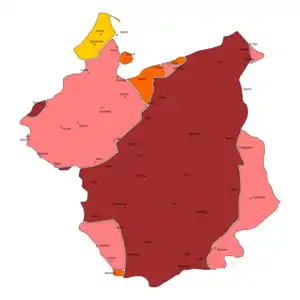
Jabłonkowanie (Polish: [jabwɔŋkɔˈvaɲɛ]) or siakanie (Polish: [ɕaˈkaɲɛ]) is a regional phonological feature of the Polish language. It consists of the merger of the series of retroflex sibilants /ʂ/, /t͡ʂ/, /ʐ/, /d͡ʐ/ ⟨sz, cz, ż, dż⟩ and palatal sibilants /ɕ/, /t͡ɕ/, /ʑ/, /d͡ʑ/ ⟨ś, ć, ź, dź⟩ into a phonetically-intermediate series [ʃʲ], [t͡ʃʲ], [ʒʲ], [d͡ʒʲ] (sometimes written ⟨śz, ćz, źż, dźż⟩).[2]
It is named after the Jabłonków subdialect of Polish (named after the town of Jabłonków in Cieszyn Silesia). It occurs in a number of other Polish subdialects.[2]
The feature is linked to the process of dispalatalization (reducing of the number of palatalized consonants) similar to the phenomena of mazurzenie and kaszubienie in other dialects.[3]
References
- ↑ Map according to Urbańczyk, Stanisław (1972). Zarys dialektologii polskiej (in Polish). Warszawa: Państwowe Wydawnictwo Naukowe.; with minor corrections based on Nitsch, Kazimierz (1958). Pisma dialektologiczne (in Polish). Wrocław–Kraków: Zakład Narodowy im. Ossolińskich.
- 1 2 "Jabłonkowanie." In: Stanisław Dubisz, Halina Karaś, Nijola Kolis, Dialekty i gwary polskie. Wyd. I. Warszawa: Wiedza Powszechna, 1995, p. 62. ISBN 83-2140989-X.
- ↑ Rospond, Stanisław (1973). Gramatyka historyczna języka polskiego (in Polish). Warszawa: Państwowe Wydawnictwo Naukowe. pp. 112–113.
This article is issued from Wikipedia. The text is licensed under Creative Commons - Attribution - Sharealike. Additional terms may apply for the media files.